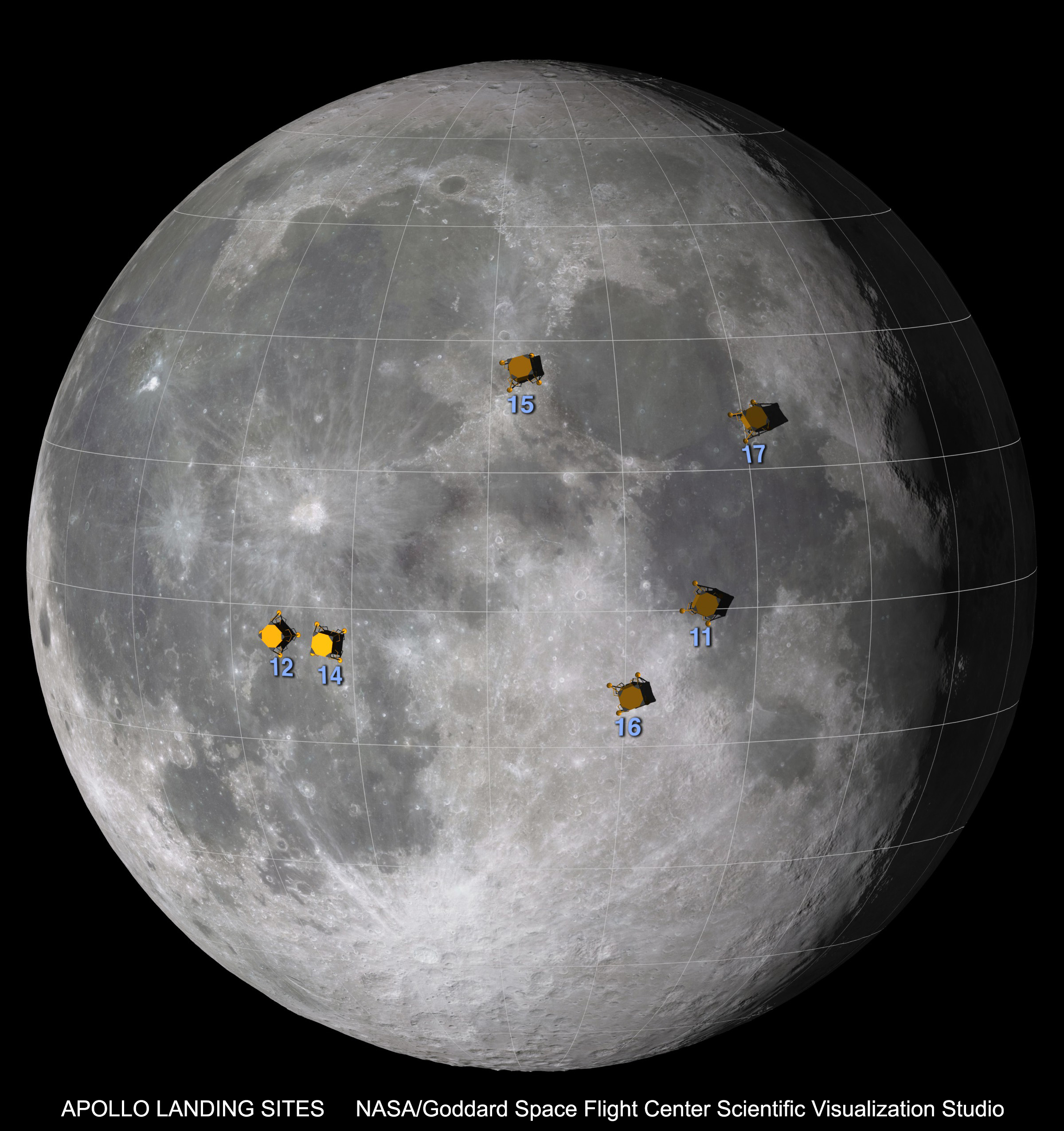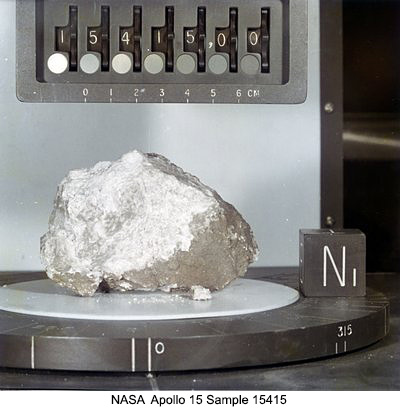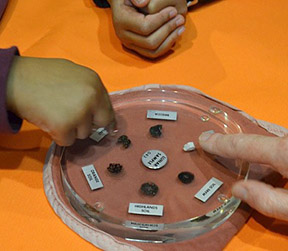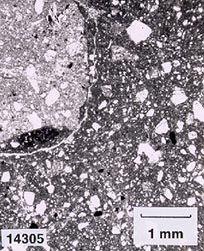Citation: Martel, L. M. V. (July, 2019) Lunar Samples Collected Up There and Down Here, PSRD, http://www.psrd.hawaii.edu/July19/lunar-samples.html.

|
July 19, 2019
Lunar Samples Collected Up There and Down Here
--- Apollo lunar samples and lunar meteorites help us understand not only the Moon and Earth, but also fundamental processes in our Solar System.
Written by Linda M. V. Martel
Hawai‘i Institute of Geophysics and Planetology, University of Hawai‘i
PSRD gives a tip of the hat to the extraordinary efforts people have made to bring back rock and regolith samples from the Moon's surface "collected up there" and lunar meteorites from strewn fields and scattered locations on Earth "down here." Analyzing these samples of the Moon in the world's laboratories has given, is giving, and will continue to give, extraordinary insights into the formation and geologic evolution of the Moon and Earth, as well as the fundamental processes in our Solar System. What's more, our cosmochemical understanding of these samples helps us to know and develop local lunar resources, essential to sustained human presence in space.
In honor of the 50th anniversary of the Apollo 11 Moon landing (July 20, 1969), as well as all Apollo missions, the ongoing meteorite-collection expeditions, and future lunar enterprises, PSRD invites you to see our collection of articles about the discoveries from research and analyses of the Apollo samples and lunar meteorites. Here we highlight and link to some of the articles from our collection [or browse the entire PSRD Archive of Moon Articles]. We also include information and (outside) links for the procedures that qualified scientists use to obtain samples for analyses and for the process educators use to borrow lunar or meteorite samples for use in the classroom, museum, library or planetarium. And for everyone, NASA has provided lunar samples for public display at museums, planetariums, and scientific expositions around the world [see the list: Apollo Lunar Sample Public Display Locations from NASA].
Apollo Samples Came From Six Landing Sites on the Moon
382 kilograms (842 pounds) of rocks and regolith were scooped, raked, hammered off, and picked up by astronauts during NASA's six Apollo Missions that landed on the Moon. An additional 16.5 meters (54 feet) of Apollo core samples are also curated. [Read the details in the The Lunar Sample Compendium, from Astromaterials Research & Exploration Science at NASA Johnson Space Center.]
 |
| Six Apollo lunar landing sites are marked on this nearside view of the Moon, all relatively near the equator. Click for enlargement. Image source. |
When you look up at the Moon at night, the bright and dark areas are composed of the rock types shown in the photographs below. Apollo missions 15 and 17 landed in geologically complex sites, giving astronauts access to highlands anorthosites (the example in the left photo) and mare basalts (example on the right). Apollo sample curator, Ryan Zeigler, told the Third Pod from the Sun podcast, "The samples from Apollo 15 and 17 are the most requested [by researchers] because they are at the junction of these two major terrains on the Moon and you can learn about both of them from one set of samples." [Listen to Third Pod from the Sun podcast: Apollo Moon Rocks, from the American Geophysical Union, posted on July 15, 2019.] The discovery of lunar anorthosites, beginning with Apollo 11, catalyzed the magma ocean theory. [See PSRD article: Scientific Discoveries from the Apollo 11 Mission.]

|

|
| [LEFT] Apollo sample 15415 is a highlands rock: course-grained, ferroan anorthosite, composed of 98% plagioclase feldspar. As a piece of the Moon's primordial crust it was given the nickname of the Genesis Rock. [RIGHT] Apollo sample 15719 is a mare rock: an ilmenite basalt. Click the photos for more information. | |
Here we list a few of the PSRD articles relating to discoveries from the Apollo samples, especially about water in and on the Moon and other volatiles. See our Archive of Moon Articles for more.
- Celebrated Moon Rocks — From 2009: Overview and status of the Apollo lunar collection: A unique, but limited, resource of extraterrestrial material.
- The Bone-Dry Moon Might be Damp — From 2008: Cosmochemists have written in stone that the Moon is almost totally devoid of water, but new analyses of volcanic glasses suggest that they need to do some editing.
- Damp Moon Rising — From 2010: Cosmochemists find more evidence for water inside the Moon, showing that it is not the bone-dry place we thought.
- The Moon's Dark, Icy Poles — From 2003: Permanently shadowed regions on the Moon–where frozen water could be trapped–are more abundant and more widely distributed than originally thought.
- Recipe for Making Water in the Lunar Regolith: Implant Solar Wind Hydrogen and Heat with Micrometeorite Impacts — From 2019: Laboratory experiments simulating space weathering on the Moon show that water can be produced by rapid heating caused by micrometeorite impacts on grains implanted with hydrogen from the Sun.
- Volcanism and an Ancient Atmosphere on the Moon — From 2017: Extensive lunar volcanism around 3.5 billion years ago produced a temporary atmosphere on the Moon.
- Volatile Elements Test Models for the Origin of the Moon — From 2019: Volatile elements that concentrate in metallic iron elucidate the processes that operated during formation and initial differentiation of the Moon.
Analyses of Apollo samples have, of course, raised new questions about the Moon and planetary processes. And multi-generational teams of researchers are set to find answers. In March 2019, NASA announced its selection of nine teams to continue the science legacy of the Apollo missions by studying samples that have been carefully stored and untouched for nearly 50 years. [Read NASA's news item: NASA Selects Teams to Study Untouched Moon Samples.] These innovative projects will include laboratory analyses of space weathering, and new investigations for gas, water, and other volatile compounds, which hold great importance for future human activities on the Moon.
Lunar Meteorites Originated from Who Knows Where on the Moon
The Meteoritical Bulletin Database lists 371 lunar meteorites [Database link to lunar meteorites]. The number is a minimum, as expeditions continue to seek and collect more meteorites. [For example, learn about the ANSMET expeditions to Antarctica in this PSRD article: Searching Antarctic Ice for Meteorites.] These samples complement the Apollo collection, adding to our understanding of global processes on the Moon and helping to refine our theories on the origin and geologic histories of the Earth and Moon. [More information and photographs are available at the site Lunar Meteorites, courtesy of Randy L. Korotev, Washington University in St. Louis, Missouri.]
Here we list a few of the PSRD articles relating to discoveries from Apollo samples and lunar meteorites.
- New Lunar Meteorite Provides its Lunar Address and Some Clues about Early Bombardment of the Moon — From 2004: A newly discovered meteorite from the Moon provides a detailed record of its history, allowing scientists to make a reasonable guess about where it came from on the Moon and to test ideas for the timing of early impact bombardment.
- Gamma Rays, Meteorites, Lunar Samples, and the Composition of the Moon — From 2005: Lunar meteorites provide ground truth to help calibrate orbital geochemical data, allowing an estimate of the composition of the entire Moon.
- Unraveling the Origin of the Lunar Highlands Crust — From 2010: Lunar meteorites contain clasts that may plausibly be samples of post-magma-ocean plutons that helped build the highlands crust.
- New Age for Lunar Exploration — From 2018: A change in the National Space Policy adds a lunar emphasis to NASA exploration programs. This article also has a nice list of lunar science concepts.
Borrowing Samples for Scientific Analyses
NASA's Astromaterials Acquisition and Curation Office provides detailed instructions and deadlines for qualified scientists; see the links below for starters.
| APOLLO SAMPLES | LUNAR METEORITES |
| Sample Requests for Research from the NASA Lunar Curation Office |
Sample Requests, Allocations, and Loans from the NASA Antarctic Meteorite Curation Office |
| Checklist for Requesting Lunar Samples from the NASA Lunar Curation Office |
How to Prepare a Meteorite Sample Request from the NASA Antarctic Meteorite Curation Office |
See also: Heck, P. R., and 29 others (2019) Best Practices for the Use of Meteorite Names in Publications, Meteoritics & Planetary Science, v. 54(7), p. 1397-1400, doi: 10.1111/maps.13291. [open access article]
Borrowing Lunar Samples and Meteorites for Education/Classroom
NASA's Astromaterials Acquisition and Curation Office provides detailed instructions for qualified educators to borrow lunar or meteorite samples for use in the classroom, museum, library or planetarium; see links below.
- Lunar & Meteorite Sample Disks – Loan Program.
- Exploring the Moon Teacher's guide with activities. Educational product for grades 4-12.
- Exploring Meteorite Mysteries Teacher's guide with activities. Educational product for grades 5-12.
- Petrographic Thin Section Set – Loan Program for universities and colleges.
- Lunar Petrographic Thin Section Set Study Guide, for loan to upper-division, university petrography courses.
 |
 |
| [LEFT] Photograph of an educational lunar sample disk, which is available for loan to educators who have completed certification to borrow a disk. [RIGHT] Photomicrograph of thin section of Apollo sample 14305, a polymict breccia. Click photos for more information from NASA. | |
|
|
[ About PSRD | Archive | CosmoSparks | Search | Subscribe ] [ Glossary | General Resources | Comments | Top of page ] |
